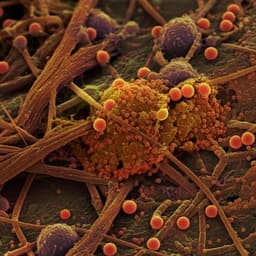
Earth Sciences
Drivers and trends of global soil microbial carbon over two decades
G. Patoine, N. Eisenhauer, et al.
This groundbreaking study reveals alarming declines in global soil microbial biomass carbon, with a loss equivalent to 149 Mt from 1992 to 2013, primarily driven by rising temperatures in northern regions. Authors Guillaume Patoine, Nico Eisenhauer, Simone Cesarz, Helen R. P. Phillips, Xiaofeng Xu, Lihua Zhang, and Carlos A. Guerra bring forth crucial insights into the dynamics of soil health and its implications for our environment.
~3 min • Beginner • English
Introduction
Soils are the largest terrestrial carbon pool and soil microorganisms underpin key biogeochemical processes, including decomposition, nutrient mineralization, nitrogen fixation, and carbon sequestration. Soil microbial biomass carbon (microbial carbon) is a widely used indicator of the size of soil microbial communities and soil health. Despite its importance, there is limited knowledge of long-term spatial and temporal dynamics of microbial carbon, constraining our ability to evaluate impacts of global change. Microbial carbon patterns are shaped by geo-climatic and soil physicochemical factors (e.g., temperature, moisture, soil organic carbon, pH, texture) and by land cover/use, which have been strongly altered by anthropogenic climate and land-cover change in recent decades. The study aims to quantify global and regional temporal trends in soil microbial carbon stocks from 1992–2013 and to identify the main drivers—climate versus land cover—of these changes, expecting climatic variables to exert the strongest influence due to their widespread and continuous effects.
Literature Review
Prior work shows microbial abundance depends on geo-climatic conditions and soil properties, with water availability and soil organic carbon (SOC) being key promoters of microbial carbon. Soil pH exerts non-linear effects, generally favoring near-neutral conditions, and influences bacterial–fungal composition. Land cover and land-use intensity modulate microbial communities via vegetation inputs and soil carbon; intensification and conversions (e.g., deforestation, grassland-to-pasture) often reduce microbial biomass and diversity. Recent decades have seen pronounced land-cover changes and climate warming/precipitation shifts, both likely to affect microbial carbon. However, interactions between climate and land cover on soil biota remain understudied, and temporal data on microbial carbon are sparse. Spatial predictions and macroecological models for soil biota (e.g., earthworms, nematodes) illustrate the utility of global modeling, but robust area-of-applicability assessments are often lacking, and sampling is spatially biased, creating blind spots that hamper generalization.
Methodology
Data: The microbial carbon dataset is an updated version of Xu et al. (2013), augmented with studies through 2016, including 762 independent entries after harmonization. Measurements were taken at mean depths above 30 cm; wetlands and bare areas (deserts) were excluded due to low sample sizes. Six harmonized land-cover classes were used: cropland, grassland, coniferous forest, tropical forest, broadleaf forest, and shrubland. Twenty-two cases (57 entries) included time series (2–6 years). Sampling spanned all continents except Antarctica, with denser coverage in Europe, North America, SE Asia, Australia, and New Zealand.
Environmental predictors: Global gridded layers included soil properties (SOC, total nitrogen, pH, sand, clay from SoilGrids), elevation (WorldClim), climate (CHELSA monthly aggregated to yearly mean temperature and total precipitation), land cover (ESA CCI reclassified to six categories), and vegetation (NOAA NDVI CDR, aggregated from daily to monthly to yearly means). Where sampling years were missing, environmental values were averaged over the five years prior to publication. For depth, values were extracted for matching SoilGrids depth layers; 5–15 cm was used when depth unspecified. To handle coordinate uncertainties and mismatches (e.g., water/urban), values were sampled within 8 km of reported sites matching the land-cover type and averaged with inverse-distance weighting.
Modeling: Random forest (R 3.6.3; packages tidyverse, raster, caret, randomForest, CAST) was used to model microbial carbon as a function of the predictors. Model settings: 500 trees (ntree), mtry=2 (minimizing RMSE), 75/25 train/validation split per resampling. One main prediction model was trained to produce yearly global predictions for 1992–2013, using year-specific climate, land cover, and NDVI layers.
Environmental coverage and area of applicability: To define where predictions are reliable, two complementary methods were applied on a 0.05° grid: (1) Mahalanobis distance to detect multidimensional environmental outliers (threshold chisq=0.975 after controlling multicollinearity); (2) Area of Applicability using a dissimilarity index (DI) based on distance to closest neighbor in training space, with locations exceeding the training DI threshold flagged as out of applicability. Locations flagged by either method were excluded; remaining 2.6 million grid cells were used for analysis.
Stock calculations and trends: Microbial carbon stocks for 5–15 cm were computed from predicted concentrations using bulk density and coarse fragment fractions following Hengl et al. For each grid cell with ≥10 years of predictions, a linear regression over 1992–2013 provided the mean rate of change (absolute and relative % per year). Regional aggregations used 17 IPBES sub-regions to sum yearly microbial carbon stocks and assess trends. To disentangle drivers, counterfactual predictions were generated by fixing either climatic variables (temperature, precipitation) or land-cover variables (land-cover class, NDVI) to their 1992 values and recomputing trends, comparing to the full dynamic model.
Validation and sensitivity: Model performance was assessed by RMSE and R² (out-of-bag cross-validated and overall) and by correlation between observed and predicted values (Pearson and Spearman; linear regressions on linear and log scales). To account for RF stochasticity, a set of 100 additional models with identical tuning provided variable importance distributions and coefficients of variation (CV) of predictions. Measurement-method sensitivity was tested by (a) refitting using only fumigation entries (72.7% of data) and comparing 2013 predictions (R²=0.97 with full-data model), and (b) including measurement method as a predictor (little improvement; RMSE=66.2, cvR²=0.41), indicating minimal method bias.
Key Findings
Predictor importance and responses: Across 100 RF runs, mean annual temperature was consistently the most important predictor, followed by soil organic carbon (SOC) and soil pH. Clay, precipitation, land-cover type, nitrogen, and sand had moderate, roughly similar importance; NDVI and elevation were least important. Partial responses indicated positive, mostly linear effects of SOC and total nitrogen on microbial carbon; non-linear declines with increasing clay, pH (decline from ~pH 4.1 to 5.8, then stable to 8.6), and temperature. Microbial carbon was much higher at mean annual temperatures below 0°C, with a sharp decrease around 0°C and relatively stable relationships at >0°C up to ~29°C. Coniferous and tropical forests had higher predicted stocks; shrublands and croplands had the lowest.
Spatial patterns and totals: Highest stocks (1.50–7.00 t ha⁻¹) occurred at high northern latitudes (coniferous forests); tropical humid regions (Amazon, Central Africa) had 0.50–1.50 t ha⁻¹; low stocks (<0.30 t ha⁻¹) in Eastern South America, Sahel-adjacent areas, East Africa, much of Australia (shrublands), and croplands (e.g., India, 0.06–0.38 t ha⁻¹). Estimated microbial carbon in the 5–15 cm layer across predictable areas was 4.34 Gt. Prediction variability (CV) was higher in the Amazon Basin, Northern Canada, and SE Russia; stable in Western Europe, Central North America, and SE Asia.
Global trends 1992–2013: For predictable regions, stocks decreased by 7.09 Mt y⁻¹, totaling a loss of 148.80 Mt (−3.4% of the predicted global microbial carbon pool; p=0.038). Northern Canada and NE Europe showed the largest absolute losses (>0.7 kg ha⁻¹ y⁻¹), alongside regions in the Amazon, Western Argentina, US East Coast, Southern South Africa, and SE Russia. The main continuous increase (>0.7 kg ha⁻¹ y⁻¹) was in central Russia, with smaller increases in India, Europe, Central North America, and parts of Africa. Relative change maps emphasized stronger proportional changes in tropical/subtropical regions with low baseline stocks.
Regional trends (IPBES sub-regions): Significant increases: Caribbean (+2.1% over 22 years, p=0.017). Significant decreases: North Africa (−4.1%, p<0.001), South America (−1.7%, p=0.010), Southern Africa (−2.6%, p=0.017), Central and Western Europe (−2.7%, p=0.034). Marginal decreases: Western Asia (−2.5%, p=0.086), North America (−7.2%, p=0.093). Other regions showed no significant change (Central Africa, Central Asia, East Africa and adjacent islands, Eastern Europe, Mesoamerica, North-East Asia, Oceania, South-East Asia, South Asia, West Africa).
Drivers: Globally, climate change (warming) primarily drove declines, with land-cover change having weaker global effects but important regional roles. Mean temperature increased by 0.28°C globally over the period. In some regions, land-cover-only dynamics were significant (positive: Central Asia, North America; negative: South-East Asia). In Western Asia (and to a lesser extent Oceania), opposing significant effects of climate and land cover led to net non-significant combined effects. Example: Central and Western Europe declined 2.9% almost entirely due to a +0.64°C temperature increase; NDVI increases and land-cover changes had little effect.
Model performance and applicability: RMSE=65.0 mmol kg⁻¹; out-of-bag cross-validated R²=0.40; overall R²=0.90; Pearson’s r≈0.59 (p<0.001) between observed and fitted concentrations (linear scale). Predictions are reliable for 50.2% of terrestrial surfaces (excluding glaciers) based on environmental coverage; lowest predictable shares in Western Asia (5.1%) and North Africa (10.6%), highest in Western/Central Europe (84.7%) and South America (63.6%). Outlier regions included NE Russia, Tibetan Plateau, parts of Africa (deciduous woodlands/savannah), Malay Archipelago, and central Amazonia.
Discussion
The study addresses the lack of temporal assessments of soil microbial biomass by generating spatially explicit, yearly global predictions and trends over two decades. Findings show a modest but significant global decline in microbial carbon stocks concentrated in high-latitude regions with large baseline stocks, largely attributable to climate warming. This aligns with theory and observations that warming reduces soil organic carbon and, subsequently, microbial biomass due to substrate limitation and altered metabolic demands. While land-cover change exerts strong local effects, its net global contribution was weaker than climate during 1992–2013, though region-specific effects were evident and sometimes counterbalanced climatic trends. Identifying vulnerable regions where high stocks coincide with negative climate or land-cover effects is critical, as declining microbial biomass risks degrading soil functions (nutrient retention, enzyme activity, aggregation) and ecosystem services, including carbon cycling and potential dark CO2 fixation. The results emphasize that climate mitigation and adaptive land management are both necessary: global-scale actions to reduce warming and local/regional strategies (e.g., conservation, rewilding, reforestation, reducing land-use intensity) to support belowground communities. The work also highlights the importance of improving data coverage and repeated sampling to reduce prediction uncertainty, particularly in underrepresented environmental spaces.
Conclusion
By integrating a global microbial carbon dataset with environmental covariates in a random forest framework, the study mapped global microbial carbon stocks (5–15 cm) and quantified their trends from 1992 to 2013. It reveals a global decline of approximately 3.4% (∼149 Mt) in predictable areas, predominantly driven by climate warming, with regionally variable contributions from land-cover change. The work identifies vulnerable hotspots where high stocks coincide with negative drivers, underscoring risks to soil ecosystem functions. It provides openly available annual maps, data, and code to inform monitoring, conservation, and management. Future research should expand sampling in underrepresented regions and environmental conditions, incorporate additional microbial facets (diversity, composition, function), improve mechanistic understanding and model structures, consider seasonal dynamics, and refine soil property inputs (e.g., bulk density) to enhance prediction accuracy and generalizability.
Limitations
- Environmental applicability: Predictions are deemed reliable for ~50.2% of global terrestrial (non-glacier) surfaces; large regions (e.g., parts of Africa, NE Russia, Tibetan Plateau, parts of Amazonia and SE Asia) fall outside the area of applicability due to environmental dissimilarity.
- Sampling bias: Spatial biases in the training data (denser in Europe, North America, SE Asia, Australia/NZ) limit extrapolation; under-sampled land-cover types (wetlands, bare areas) were excluded.
- Temporal constraints: Only up to 22 annual predictions per grid cell; year-to-year climate variability is high; seasonal dynamics were not modeled (annual resolution, no temporal autocorrelation modeled).
- Model constraints: Random forest stochasticity can affect variable importance and predictions; addressed via 100-run variability assessment but residual uncertainty remains. Limited ability to infer causality; interactions may be complex (e.g., precipitation effects).
- Validation: No independent external dataset with adequate spatio-temporal coverage was available for validation; performance assessed via cross-validation and fit to training data.
- Stock estimation inputs: Potential biases in global bulk density estimates (notably at high latitudes), though mitigated by excluding very high latitudes and focusing on 5–15 cm depth.
- Depth and ecosystems: Focus on 5–15 cm layer; wetlands and deserts excluded; results may not generalize to these systems or other depths.
Related Publications
Explore these studies to deepen your understanding of the subject.







